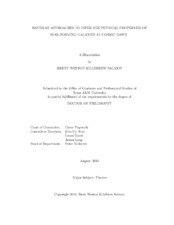| dc.description.abstract | In this thesis, I seek to advance our understanding of galaxy formation and evolution in the early universe. Using the largest single project ever conducted by the Hubble Space Telescope (the Cosmic Assembly Near-infrared Deep Extragalactic Legacy Survey, CANDELS) I use deep and wide broadband photometric imaging to infer the physical properties of galaxies from z=8.5 to z=1.5. First, I will present a study that extends the relationship between the star-formation rates (SFRs) and stellar masses (M*) of galaxies to 3.5<z<6.5, improves the constraints on the distant star-formation histories, and resolves an outstanding puzzle in the redshift evolution of the specific SFR (sSFR = SFR/M*).
To improve determinations of distant galaxy SFRs, I then place new constrains on how dust is attenuated in galaxies. I calculate the Bayesian evidence for galaxies under different assumptions of their underlying dust-attenuation law. By modeling galaxy ultraviolet-to-near-IR broadband CANDELS data I produce Bayesian evidence towards the dust law in individual galaxies that is confirmed by their observed IR luminosities. Moreover, I find a tight correlation between the strength of attenuation in galaxies and their dust law, a relation reinforced by the results from radiative transfer simulations.
Finally, I use the Bayesian methods developed in this thesis to study the number density of SFR in galaxies from z=8 to z=4, and resolve the current disconnect between its evolution and that of the stellar mass function. In doing so, I place the first constraints on the dust law of z>4 galaxies, finding it obeys a similar relation as found at z~2. I find a clear excess in number density at high SFRs. This new SFR function is in better agreement with the observed stellar mass functions, the few to-date infrared detections at high redshifts, and the connection to the observed distribution of lower redshift infrared sources. Together, these studies greatly improve our understanding of the galaxy star-formation histories, the nature of their dust attenuation, and the distribution of SFR among some of the most distant galaxies in the universe. | en |


